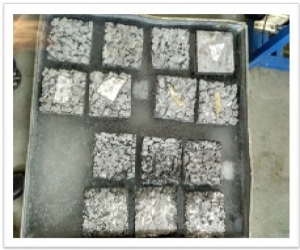


Rs 81 only/-
8872658610 miraj03alam92@gmail.com
ABSTRACT
The concrete paste then coats the aggregates and allows water to pass through the concrete slab. The process of selecting suitable ingredients of concrete and determining their relative amounts with the objective of producing a concrete of required strength, durability, and workability as economically as possible, is termed as concrete mix design. There are three types of mixes-
1) Nominal mix
2) Standard mix
3) Design mix
In this project, the strength and permeability of pervious concrete was compared with M15 grade conventional concrete. And various other concrete mix like boring soil &lime based concrete, cement concrete with different amounts of fine aggregate and fly-ash were also tested for their compressive strength. Tests for workability of concrete were also done on different concrete mix. Also, the laboratory and field tests were done for fine aggregate, course aggregate, etc.
The strength properties of pervious concrete often refer to the compressive strength, flexural strength and split tensile strength. This report mainly explains about the compressive strength of different samples.
The mix proportion is achieved from M15 grade of concrete in which the sand is eliminated in one sample, and for other samples the sand is increased by 5%. The water cement ratio in pervious concrete samples has been chosen as 0.3 and OPC43 grade cement is used. In addition, 20% of quantity of cement has been replaced with fly ash in each pervious sample. The pervious concrete cube is casted with cube size of 150mm×150mm×150mm and they were cured in water for the period of 7, 14 & 28 days. The compressive strength test is done in laboratory after curing. Then the compressive strength of pervious concrete is compared to compressive strength of M15 grade of concrete.
OBJECTIVE
(i) To study & determine the strength property of different concrete mix
(ii) To compare compressive strength, workability of pervious concrete to compressive strength of M15 concrete.
(iii) To select suitable ingredients of concrete and determine their relative amounts with the objective of producing a concrete of required strength, durability and workability.
(iv) To study the importance & use of pervious concrete to address important environmental issues and support green sustainable growth
(v) To study the ability of pervious concrete to lower overall project costs on a first cost basis.
METHODOLOGY
The entire project is planned in nature. The methodology followed in this project
can be listed as below :
(i) Calculation of the materials required for execution of project
(ii) Carrying out different field test on the ingredients of concrete mix.
(iii) Preparing samples according to different mix
(iv) Carrying out field test on prepared concrete mix of the samples
(v) Placing the concrete mix in cube moulds
(vi) Removing the concrete from cube moulds
(vii) Placing the cubes for curing for 7 , 14 , 28 days
(viii) Testing compressive strength after curing
(ix) Testing permeability through field test on pervious concrete..
(x) Comparing the different properties of pervious concrete with conventional concrete.
MAJOR CONCRETE MIX DESIGN EXPERIENCE
Experience in design of the following types of concrete mix has been gained during the entire project:
(i) M15 grade concrete (1:2:4)
(ii) 0% sand pervious concrete
(iii) 5% sand pervious concrete
(iv) 10% sand pervious concrete
(v) Concrete with 10% cement and 90% replaced by (20% fly-ash, 30% boring soil, 40% lime)
Conclusiotn
In this project, we designed the following concrete mixes-
Conclusion
The strength of pervious concrete with various percentage of sand was compared to conventional concrete &
From the compressive strength test we concluded that the strength of concrete with 0% sand has adequate strength compared to strength of m15 concrete. And has max. porosity. Thus, pervious with 0% to 5% sand should be used for pavement purpose to drain rain water and storm water run off.
In India, pervious concrete will become more popular in future due to increased urbanization and reduced water level.
| Doc | Complete Document in MS Word |